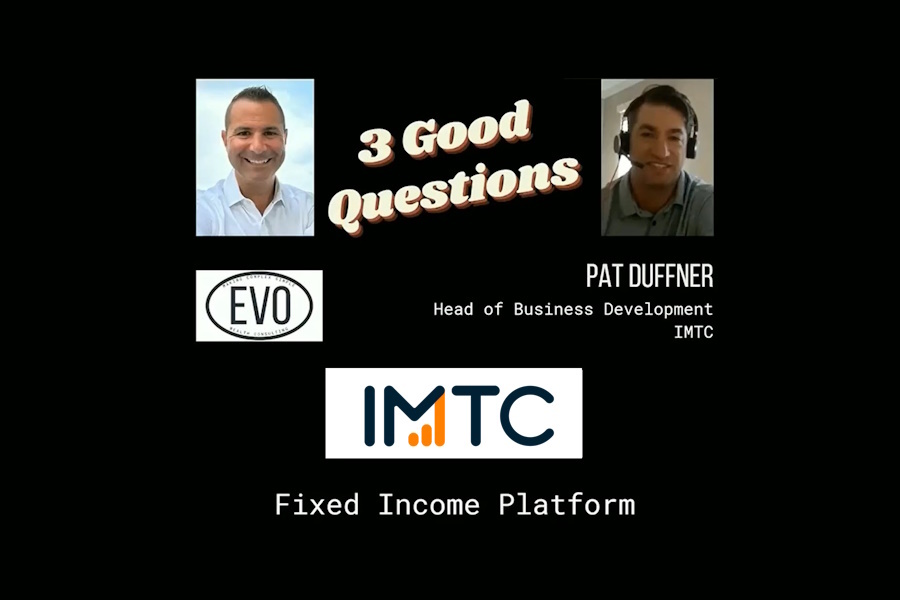6 Key Takeaways on the Future of Fixed Income from the 2020 Fixed Income Leaders Summit

The Fixed Income Leaders Summit held online between December 8th and 10th, 2020, provided an excellent opportunity for industry leaders to identify developments in the fixed income market over the past year and predictions for the future. In particular, it highlighted how the COVID-19 pandemic accelerated some of the key trends already underway in the market, including the acceleration in adoption of innovative technologies. Meanwhile, 2021 is forecasted to be another challenging year, though it should also see the emergence of game-changing technologies.
This time of year is when asset managers release their capital markets assumptions for fixed income and other asset classes over the next 12 months. Reviewing the outlooks released towards the end of 2019 provided a salutary reminder of the old adage that while ‘man plans, Gods laughs.’ Certainly, nobody could have anticipated the global pandemic that rendered those forecasts obsolete. Yet while yields have ended 2020 at much lower levels than might have been expected 12 months ago, many of the fundamental themes driving fixed income markets have been reinforced rather than altered by the pandemic.
1. A continued need for transparency across fixed income
Conference participants agreed that one of the industry’s key issues is the lack of transparency – specifically around three areas of insights.
- Pricing: Price discovery for traders and portfolio managers is difficult, particularly during the volatility over the past year. Many are testing evaluated and predictive pricing models to gain more insight into trades, given the importance of real-time quotes in achieving best execution.
- Liquidity: The lack of liquidity, particularly in high yield and muni secondary markets, eats away at alpha. As the industry improves transparency, liquidity will improve, which opens opportunities for many investors. The key to enhancing liquidity relies on new technology adoption.
- Pre- and post-trade analytics: Pre-trade, post-trade, and execution data are often still siloed, with the fragmentation causing a lack of ability to digest critical insights easily. Fixed income managers surveyed said the biggest challenge on the desk today is aggregating pre-trade data (62% of respondents). It’s clear the solution is for innovative technology to add clarity and ease to this data.
However, it is not only about just having access to data. The pandemic and working remotely made it acutely clear for the need to have the best quality, clean data that is also aggregated well. One participant even talked about the “dream of living on one screen.” With that said, in order to live on one screen, it is essential to have an integrated tech stack to develop an end-to-end investment process.
2. Active management requires a shift to customize portfolio strategies at scale
Fixed income leaders recognize that clients are becoming increasingly demanding in seeking individual solutions that address their needs. In response to the rise of passive investing, active managers both need to differentiate their services but also provide them at lower costs. When developing mass customization, it’s only possible through the creation of systematic strategies and automation. For example, an SMA manager should be able to look across all their accounts, analyze positions and allocate trades, enabling solutions to scale. Adopting new technology is critical in meeting these demands while also helping deliver the contradictory requirement for lower cost fixed income solutions in a world of declining yields.
3. The pandemic accelerates the adoption of technology
Without adopting new technology, firms will undoubtedly be left behind. While exploring tech enhancements was a big factor for investment shops prior to the pandemic, it’s estimated that COVID accelerated the pace by 5-10 years. Crises often fuel mass innovation, which could mean there is a significant investment in new technology over the next year. What’s the prediction for the area that most needs innovation? Portfolio management and research, often the biggest source of operation cost, need dramatic efficiency gains.
Even though there’s a great need for more data to improve transparency, the already increasing volume of data available to market participants is both a curse and a benefit in gaining a market edge. Without effective tools to sift through all this data and provide information that market players can apply, the vast data means that investment decisions take longer. According to conference participants, those at the cutting edge of the industry are making the best use of the new technologies as fixed income undergoes a digital revolution.
What do most fixed income leaders want from their tech?
- Eliminate mundane, manual processes to become exponentially more efficient
- Provide enhanced insights that are aggregated to make stronger investment decisions
- Integrate with other systems to have data visibility on one platform
- Enable collaboration amongst the team and firm to provide faster, better results for clients
- Work with software that is easy-to-use and intuitive to navigate
The range of data and technology solutions available varies from one asset class to another, with municipal bonds lagging in many respects, reflecting the fragmented and illiquid nature of this asset class. There are challenges around muni information because much of it can not be processed by machines due to a lack of standardization with official documents. Due to the general lack of innovation in the municipal market over the past 40 years, market participants tend to be less willing to change and adopt to new technology.
4. AI and machine learning move fixed income into the future
Personal life technology is driving the expectations for business technology, and we’re increasingly seeing the benefits of a world of man + machine. Initially, many feared the rise of AI in investment management would mean lost jobs and the automation of investing; however, it’s now clear the opposite is true. In order to process the sheer amount of data and complex situations in a time frame quick enough impact alpha, AI and machine learning are becoming a necessity.
One area gaining traction is natural language processing and machine learning in standardizing and digesting unstructured data, whether assessing ESG factors or muni terms and conditions. It adds speed to otherwise time-consuming processes and can help determine where to find relative value in the market.
Fixed income also has many risk factors, including credit, duration, inflation, and currency risk; assessing these risk factors is a key area of machine learning innovation. Algorithmic models’ goal is generally to minimize errors and risk, though this also means the model is king. Determining how models will behave during stress periods is one of the biggest challenges due to a lack of liquidity and market fragmentation. Humans will always need to drive the machine because they understand shifts in market sentiment and positioning that machines do not.
5. Growing demand for sustainable solutions and a focus on diversity
There is no doubt that ESG is becoming mainstream in fixed income, often applied in customized solutions. This year, a key differentiator is a shift from sustainability being an investment priority based on values to a discussion about competitive returns. There was also agreement that the lack of consistent and reliable data is a problem in applying technological solutions in this area – particularly with ratings. Firms are developing their own standards and methodologies for ESG criteria and rankings, which need to be defendable to clients. Additionally, investors are finding that authenticity in the area of responsible investments is paramount. If the people who manage responsible investment strategies do not believe in them, why should the client?
According to conference attendees, diversity and inclusion have also grown in its importance over the past year to build stronger teams with more well-rounded opinions and ideas. The key to building more diverse teams include: a greater emphasis on sponsorship rather than mentorship with junior employees; creating safe spaces where individuals from different backgrounds can share experiences; regular executive meetings to ensure diversity and inclusivity strategies are being executed; ensuring job descriptions and the interview process appeal to talent from the broadest range of backgrounds. Actively addressing diversity in investment firms is only poised to expand in 2021.
6. 2021 to be a bifurcated year with a challenging 1H and an explosion in 2H
Looking forward, there are predictions that cutting-edge technology would emerge in 2021 in the area of portfolio management and research, an area that needs the most workflow efficiency gains, and a dramatic year for innovation across tech. Certainly, market participants are likely to need all the help they can get in the first half of the year, given the predictions that 2021 will be volatile until the COVID vaccine is distributed broadly (given it is effective). The positive note is the anticipation of an explosion in activity and markets once economies can open back up 100%.
Technology is only as good as how it is used. IMTC is designed by and for fixed income professionals, empowering them to take action and make decisions quickly and accurately with real-time data and analytics capabilities. It allows you to future-proof your business; driving operational efficiencies, mitigating risk and delivering performance, to ultimately enable business growth.
This paper is intended for information and discussion purposes only. The information contained in this publication is derived from data obtained from sources believed by IMTC to be reliable and is given in good faith, but no guarantees are made by IMTC with regard to the accuracy, completeness, or suitability of the information presented. Nothing within this paper should be relied upon as investment advice, and nothing within shall confer rights or remedies upon, you or any of your employees, creditors, holders of securities or other equity holders or any other person. Any opinions expressed reflect the current judgment of the authors of this paper and do not necessarily represent the opinion of IMTC. IMTC expressly disclaims all representations and warranties, express, implied, statutory or otherwise, whatsoever, including, but not limited to: (i) warranties of merchantability, fitness for a particular purpose, suitability, usage, title, or noninfringement; (ii) that the contents of this white paper are free from error; and (iii) that such contents will not infringe third-party rights. The information contained within this paper is the intellectual property of IMTC and any further dissemination of this paper should attribute rights to IMTC and include this disclaimer.





